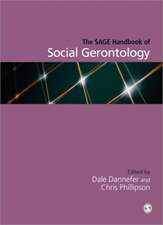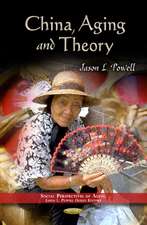Elderburbia: Aging with a Sense of Place in America
Autor Philip B. Stafford Cuvânt înainte de Scott Russell Sandersen Limba Engleză Hardback – 12 oct 2009 – vârsta până la 17 ani
Preț: 346.25 lei
Preț vechi: 476.58 lei
-27% Nou
Puncte Express: 519
Preț estimativ în valută:
66.26€ • 68.73$ • 55.25£
66.26€ • 68.73$ • 55.25£
Carte tipărită la comandă
Livrare economică 27 martie-10 aprilie
Preluare comenzi: 021 569.72.76
Specificații
ISBN-13: 9780313364365
ISBN-10: 0313364362
Pagini: 208
Ilustrații: 9 bw illus
Dimensiuni: 156 x 235 x 25 mm
Greutate: 0.48 kg
Ediția:New.
Editura: Bloomsbury Publishing
Colecția Praeger
Locul publicării:New York, United States
ISBN-10: 0313364362
Pagini: 208
Ilustrații: 9 bw illus
Dimensiuni: 156 x 235 x 25 mm
Greutate: 0.48 kg
Ediția:New.
Editura: Bloomsbury Publishing
Colecția Praeger
Locul publicării:New York, United States
Caracteristici
20 individual profiles of community development initiatives and design guidelines for elder-friendly communities, participatory research, and planning methods
Notă biografică
Philip B. Stafford, PhD, is the director of the Center on Aging and Community and the Indiana Institute on Disability and Community and adjunct professor in the Department of Anthropology at Indiana University, Bloomington, IN.
Recenzii
A leader of aging, disability, and community based in Indiana, Stafford contributes only slightly, he says, to fuller discussions elsewhere about how American suburbs will have to be retrofitted for the elderly. His main concern is about the places older people call home, about homemaking in a sense of dwelling and belonging rather than cooking and cleaning. Among his topics are locating old age, memory and the creation of place, aging in third places, new forms of association in old age, and design guidelines for the new elderburbia.
Elderburbia couldn't be a timelier book, as planning departments across the country are in the process of evaluating the demographics and health and housing needs of their age 65 and older population.
[O]ffers a take on getting old that gets away from the dreary options that dominate popular discourse: fade away, unloved, in a substandard nursing home or exercise hard enough, eat right enough, and save money enough to remain middle-aged up to the end. Stafford argues we should be thinking instead about the importance of place, and he takes a close look at why some places work better than others in helping elders thrive.
"An anthropologist with a folklorist's sensibility, Phil Stafford has written a book that is unique in the literature of gerontology. Folklorists will appreciate Stafford's sensitivity to performance (formulaic speech and genre), artistry, and tradition, as well as the centrality of community and a shared history. . . . Stafford offers an especially thoughtful look at memory as a cultural resource, personal, but perhaps more importantly, shared. . . . This book contains some poignant insights into the experience of aging, particularly in the book's final chapter. . . . [I]t will speak to all of us who care deeply about our place in community, especially as we seek ways to age in place 'in its profound sense'".
Elderburbia couldn't be a timelier book, as planning departments across the country are in the process of evaluating the demographics and health and housing needs of their age 65 and older population.
[O]ffers a take on getting old that gets away from the dreary options that dominate popular discourse: fade away, unloved, in a substandard nursing home or exercise hard enough, eat right enough, and save money enough to remain middle-aged up to the end. Stafford argues we should be thinking instead about the importance of place, and he takes a close look at why some places work better than others in helping elders thrive.
"An anthropologist with a folklorist's sensibility, Phil Stafford has written a book that is unique in the literature of gerontology. Folklorists will appreciate Stafford's sensitivity to performance (formulaic speech and genre), artistry, and tradition, as well as the centrality of community and a shared history. . . . Stafford offers an especially thoughtful look at memory as a cultural resource, personal, but perhaps more importantly, shared. . . . This book contains some poignant insights into the experience of aging, particularly in the book's final chapter. . . . [I]t will speak to all of us who care deeply about our place in community, especially as we seek ways to age in place 'in its profound sense'".








